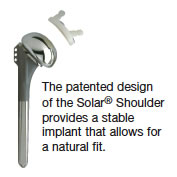Ready to Consider Shoulder Joint Replacement?
Some Things You Should Know
Replacement of an arthritic or injured shoulder is less common than knee or hip replacement. When necessary, however, shoulder replacement typically provides the same potential benefits as those procedures, including relief of joint pain and restoration of more normal joint movement.
Restoration of movement is particularly important in the shoulder, the body mechanism that allows your arm to rotate in every direction. If you’re experiencing severe shoulder pain and reduced shoulder movement, there are probably many daily activities you can no longer do — or do as well or as comfortably — as before your shoulder problems began.
Shoulder Joint Replacement Surgery
In shoulder replacement surgery, the artificial shoulder joint can have either two or three parts, depending on the type of surgery required.
- The humeral component (metal) is implanted in the humerus.
- The humeral head component (metal) replaces the humeral head at the top of the humerus.
- The glenoid component (plastic) replaces the surface of the glenoid socket.
There are two types of shoulder joint replacement procedures:
1. A Partial Shoulder Joint Replacement is used when the glenoid socket is intact and does not need to be replaced. In this procedure, the humeral component is implanted, and the humeral head is replaced.
2. A Total Shoulder Joint Replacement is used when the glenoid socket needs to be replaced. All three shoulder joint components are used in this procedure.
How Long Will an Artificial Shoulder Joint Last?
How long a joint replacement will last is impossible to predict. Individual results vary. As successful as most of these procedures are, over the years the artificial joints can become loose and unstable or wear out, requiring a revision (repeat) surgery. Many factors determine the outcome including:
- Age
- Activity level
- Bone strength
- Bone quality
- Disease progression
Loosening is a common cause of joint replacement surgery failure. A small amount of loosening and bone loss will occur. If it reaches a certain degree, a revision surgery may be indicated.
<< Previous Page || Next Page >>
